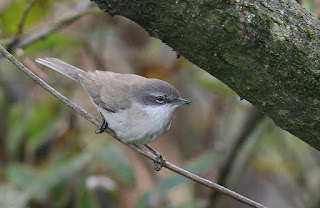Pink-footed Goose, Ballydavid, 30th November 2016 (M.O'Clery)
A very confiding adult individual, sticking to the same patch of coastal grassland along the coastal path near Ballydavid for a week or so now, and a beautiful spot to see such a bird.
If Carlsberg did coastal walks... Pink-footed Goose is asleep in lower foreground, slightly left of centre.
Pink-footed Goose, Ballydavid, 30th November 2016 (M.O'Clery).
However, when a goose offers such superlative close views, there must be a modicum of doubt as to its' provenance. This bird had no rings, the wings were perfect, and there were no other physical signs of a captive origin. But tameness in wildfowl can be incriminating. An escaped bird from a collection? Or a wild bird, perhaps injured or unwell, separated from the flock, and the imperative of the need to feed overriding natural wariness? Hard to know, but this bird allowed approach to within about 15 metres after a little judicious 'keeping a low profile'. By that I mean, using contours to mask my approach, hunkering down, and avoiding sudden movements. I didn't mean refusing to log in to FaceBook, not answering the phone and wearing a hoodie in public places.
In most of the areas throughout Ireland, where flocks of grey geese might be found, you would do well to approach in the open to within 300 metres before the whole lot took off in panic.
In any case, whether it is wild or not, it was an exceptionally beautiful place to see such a bird, and in glorious winter sunshine, perfect calm and a flawless blue sky. I didn't offer it any bread in case it came waddling up to be hand-fed, thus destroying the illusion.
Pink-footed Goose, Ballydavid, 30th November 2016 (M.O'Clery).
(Click on the arrows symbol for full HD)
Pink-footed Goose, Ballydavid, 30th November 2016 (M.O'Clery).
Proper Rock Dove, Ballydavid, 30th November 2016 (M.O'Clery).
At least the local Rock Doves had the decency to be wary, and a close look at the plumage of ten or so along the coastal path confirmed there were no rings, no cinnamon-coloured tails, no virus-infected stumps of legs, or wedges of white in the wing. None of them pecked idly at a cigarette butt, or tried to rip the wrapper off a discarded burger. They looked and acted like the real deal...













































